Eight
years ago, we had a great experience sea kayaking in Glacier Bay, so
Nancy looked for something similar as an excursion for this trip. The
company that did the Glacier Bay cruise/kayaking trips didn't seem to
be doing that anymore, but Nancy found a trip involving sailing and sea
kayaking in the Kenai Fjords National Park that looked pretty
interesting, so we booked that. It was with Kayak Adventures Worldwide
(http://www.kayakak.com) in Seward. The trip involved sailing from
Seward to Aialick Bay (in the national park) and an afternoon of
kayaking on the first day, followed by a full day of kayaking, and then
kayaking in the morning and sailing back to Seward in the afternoon of
the third day. The sailboat, the "S/V Swan", was a 61 ft. ketch-rigged
motor-sailor (http://www.alaskasailingtours.com). Being active seniors,
we wanted a "mellow trip", and not one where we had to keep up with a
bunch of young jocks. So we were paired with a family with two children
(ages 9 and 11) that worked out fine for us. Counting us, the sea
kayaking guide, the ship captain, and one ship crewman, there were a
total of nine people onboard the 61 foot sailboat.
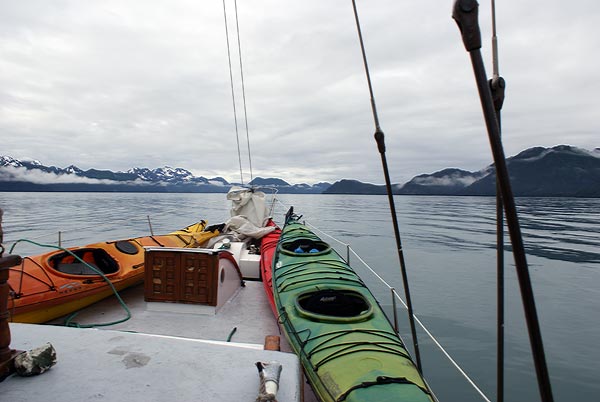
Heading out from Seward. The wind was calm so we motored all the way to Aialick Bay. The weather was looking pretty bleak. The forecast was for at least three days of clouds and rain, so it was holding true so far. Earlier we had asked Dave Doughty, who runs Kayak Adventures, what they do if the weather is bad. The response - in case of storms they cancel, but clouds and rain are not sufficient reason to cancel. He said, " In Alaska, if you won't kayak in the rain, then you won't do much kayaking." He added, " Just dress for the weather and you will be just fine."

Passing by bear glacier. To me it is pretty glacier with that moraine down the middle. It terminates in a lagoon and not on the bay, so it is not a tidewater glacier and doesn't exhibit calving.
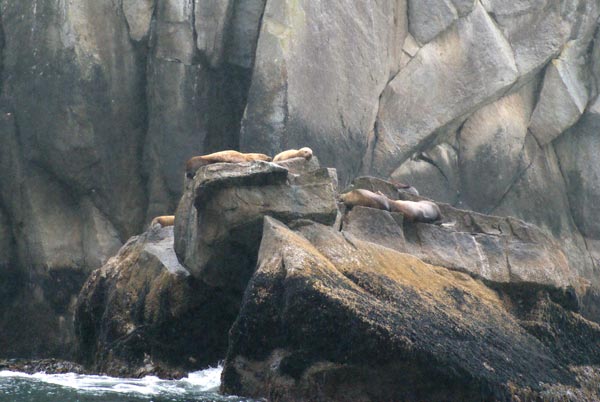
Seals laying out on the rocks.
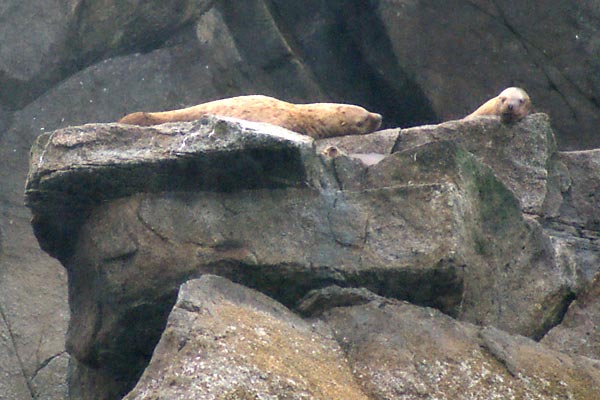
The seals expressed little concern about our passing by. A turned head was about the only indication that they were aware of us.
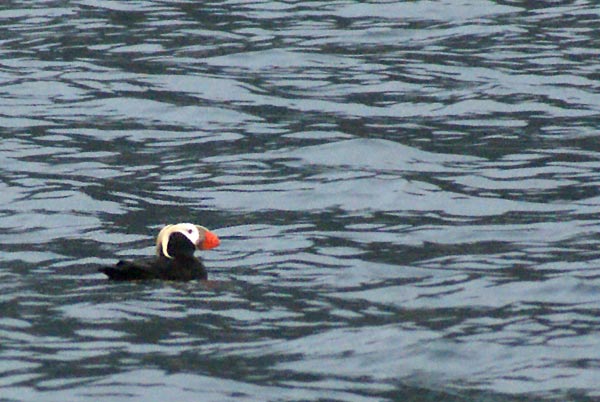
We saw a lot of puffins. These funny looking birds are great swimmers and divers, but have to do a lot of flapping of the wings to get airborne, sort of like a loon.
We also saw a few whale spouts and a humpback whale dive, but I didn't get a picture. It happened too fast; I just stood there in awe as the whale's tail came up into the air and then disappeared underwater. It seemed to be a whale by himself; we didn't see any others around. When a humpback dives like that, they usually go deep and don't surface for 20 to 30 minutes.
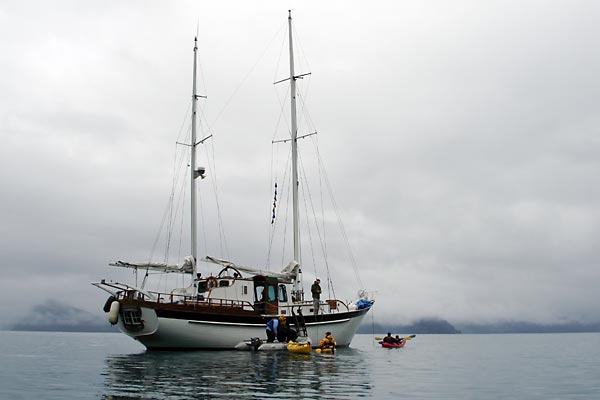
Upon arriving at Quicksand Cove in Aialick Bay, we put the kayaks in the water for our initial lesson in kayaking. Our guide, Jusine, assumed we were all beginners, which was appropriate since we hadn't done any sea kayaking for eight years.

Justine, our guide, demonstrating paddling skills. She was a good teacher.

Investigating a waterfall.
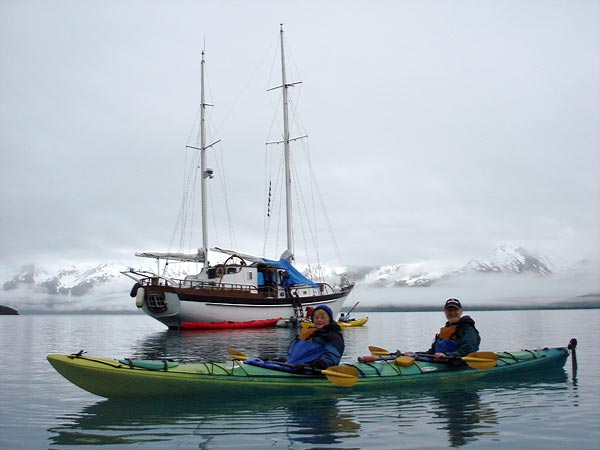
The second day we headed for Aialick Glacier. Nancy and I waiting for the others to put in. We boarded the kayaks from a zodiac raft tied to the sailboat. It worked pretty well. When starting from shore you have to wade out into the water first before you get into the kayak, so you get wet. But this procedure kept us pretty dry. With all the rain, there was some water in the zodiac and the kayaks, and the kayak seats were wet, so you couldn't stay perfectly dry.
(photo by Justine)
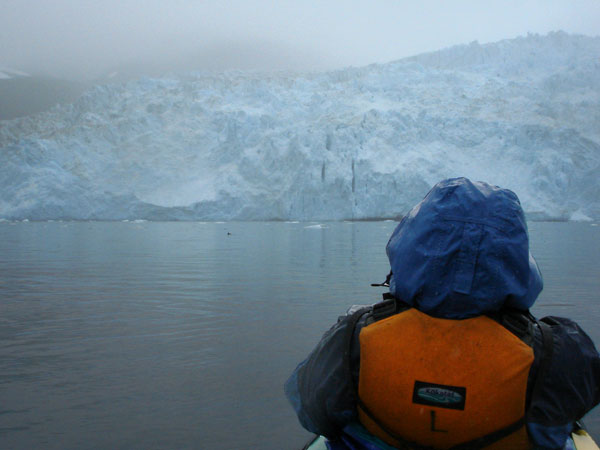
Nancy in front of Aialick Glacier. It is a large tidewater glacier, about a mile across and 600 feet high at the face. When it calves (huge chunks of ice falling into the water), it sounds like thunder that can be heard two to three miles away. Our guide had us stay at least a half mile away so we didn't get hit by the wake when it calves.

Cathie (the mother) and Grace, part of the family kayaking with us, in front of Aialick glacier.
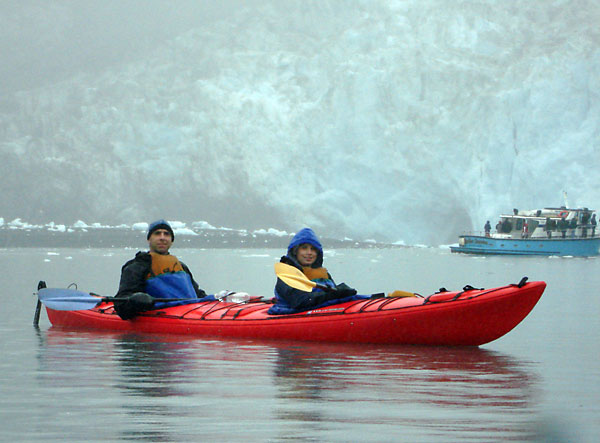
Pete (the father) and Mike, the other half of the family kayaking with us. The kids were a lot of fun and did pretty well with the kayaking. In the background is a national park service boat doing some reseach in the area.
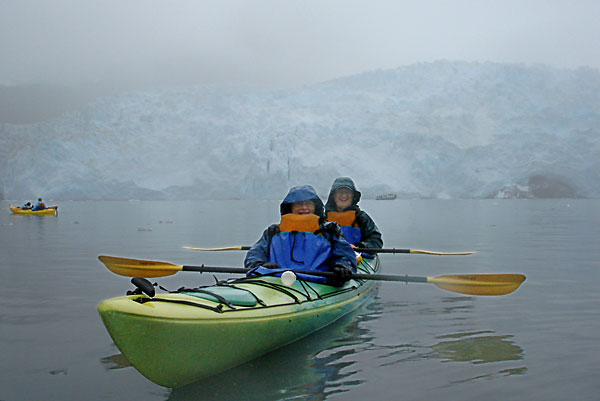
We are somewhere under those hoods. It rained or drizzled more often than not the entire three days, with no sight of the sun at all. But we discovered that Dave was right; if you dress for the weather, it is still a lot of fun.
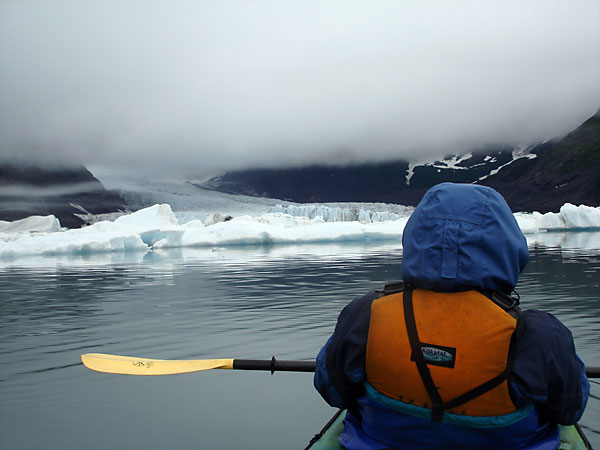
After lunch back on the sailboat, we went to see Pederson glacier. This is a smaller glacier that terminates in a lagoon, rather than the bay, so it doesn't calve. The lagoon is accessible by kayak only near high tide. We went in somewhat before high tide, so we let the current take us into the lagoon. Coming out, however, the current had not yet reversed, so we had to paddle against the current; it was payback time.

Since Pederson terminates in a lagoo, you can get up pretty "close and personal" to the ice in the lagoon. Neat!

Justine is calling us to "pod up". She used the analogy of orcas traveling in pods for mutual protection.
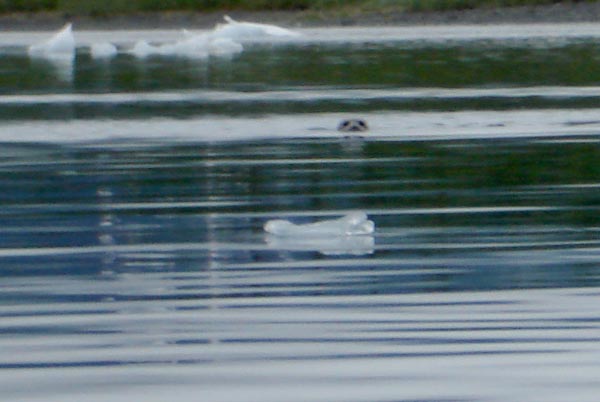
That two-eyed "monster" looking our way is not the Loch Ness monster; it is a seal. We saw several seals in the lagoon, but none hauled out on the ice, so this was the best I could do for a picture.\
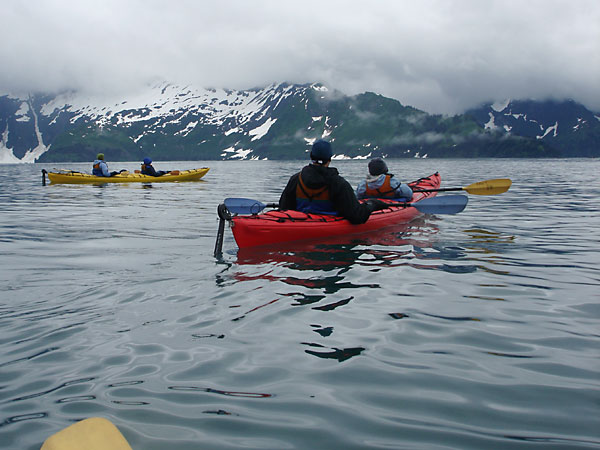
Back in Aialick Bay. The clouds and fog gives it a mystical feeling; very scenic and not like all the picture postcards you see so often.
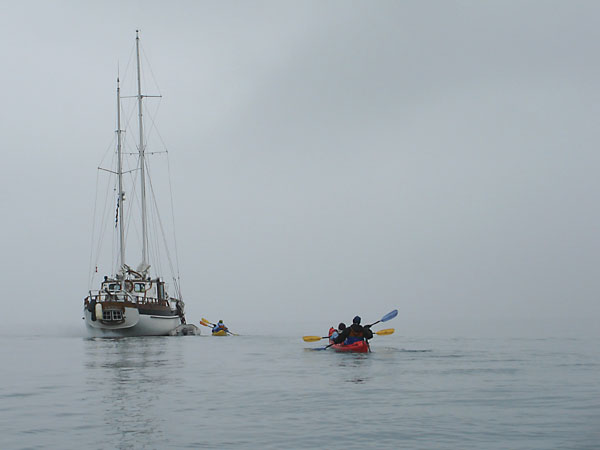
The sailboat motored over to pick us up we didn't have to kayak so far back to it. This also gave us more time to get to where we would spend the night.
After dinner we learned that the weather forecast for the next day was turning bad. They were forecasting strong winds and heavy seas in an area we needed to travel through.. So the captain and the guide decided it would be better to head back into Resurrection Bay (where Seward is located) tonight and put into a cove there for kayaking the next day. That would put us in safer waters when the storm came in.

Underway to the next location a pod of Dall's porpoises paid us a visit. It is pretty exciting watching them play in the boat's bow wake. The zip from side to side, sufacing briefly, and passing under the boat. It is amazing to watch.
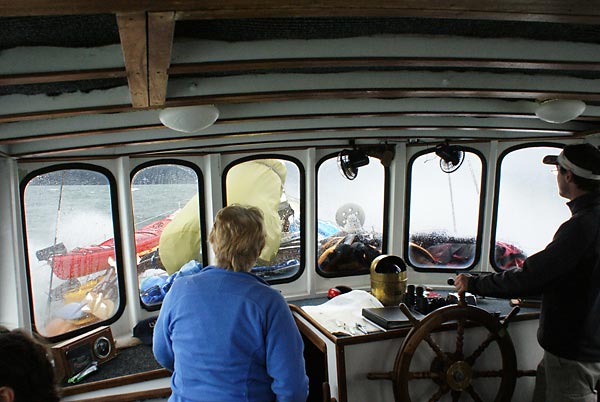
After spending the night and kayaking the next morning in Humpy cove, just north of Fox Island, we headed back to Seward. The cove was very protected, but the wind was pretty strong with white caps out in the main part of the bay. It was a bouncy ride with a lot of spray on the way back. Alan is at the wheel while Nancy tries not to look too concerned. Click here for a short video clip (4.1 MB) of the ride.
Listening to the marine radio during the trip was interesting. A fishing boat not too far away had lost its main engine. The captain was radioing for someone to tow him back to Seward. Another fishing boat offered to pick him up and give him a tow. The captain of the second boat became concerned, however, about the strain on his engine and asked for assistance. A woman in Seward (in the harbormaster's office?) got into the act and contacted a third fishing boat to see if they could help. They agreed and came to pick up the tow. All this was taking place within a couple of miles of us, so we could see the boats involved as well as hear the radio communications. For some reason, the third boat was having difficulty contacting the second boat, so the woman was relaying messages between the two. It seemed to us that, in relaying messages, she was exaggerating the seriousness of the situation. The Coast Guard was listening in on the communications as well and radioed in to ask if they were needed to provide assistance; they were from the Kodiak air station, so I'm not sure what they would have done. It all ended well, with the first boat being towed to a landing where a trailer had been brought to take it to a repair facility. Our captain, Greg, and his assistant, Alan, knew the people involved and the boats, so they could give us the local perspective. It was like a real-life soap opera.
It was a great trip! We learned that, even with all the clouds, fog, and drizzle, we can kayak in cold, wet weather, and enjoy it. Our guide and ship's crew were very experienced, knowledgeable and helpful. Coming back to the sailboat after kayaking and changing into dry clothes was a luxury. The captain did all the cooking and fed us very well, so we were treated like royalty. My one regret was that we didn't do much sailing; except for a few hours during the second night we were motoring without using the sails. But that was because of the weather and wind conditions; no one has any control over that. Would we do it again? Absolutely!

Heading out from Seward. The wind was calm so we motored all the way to Aialick Bay. The weather was looking pretty bleak. The forecast was for at least three days of clouds and rain, so it was holding true so far. Earlier we had asked Dave Doughty, who runs Kayak Adventures, what they do if the weather is bad. The response - in case of storms they cancel, but clouds and rain are not sufficient reason to cancel. He said, " In Alaska, if you won't kayak in the rain, then you won't do much kayaking." He added, " Just dress for the weather and you will be just fine."

Passing by bear glacier. To me it is pretty glacier with that moraine down the middle. It terminates in a lagoon and not on the bay, so it is not a tidewater glacier and doesn't exhibit calving.

Seals laying out on the rocks.

The seals expressed little concern about our passing by. A turned head was about the only indication that they were aware of us.

We saw a lot of puffins. These funny looking birds are great swimmers and divers, but have to do a lot of flapping of the wings to get airborne, sort of like a loon.
We also saw a few whale spouts and a humpback whale dive, but I didn't get a picture. It happened too fast; I just stood there in awe as the whale's tail came up into the air and then disappeared underwater. It seemed to be a whale by himself; we didn't see any others around. When a humpback dives like that, they usually go deep and don't surface for 20 to 30 minutes.

Upon arriving at Quicksand Cove in Aialick Bay, we put the kayaks in the water for our initial lesson in kayaking. Our guide, Jusine, assumed we were all beginners, which was appropriate since we hadn't done any sea kayaking for eight years.

Justine, our guide, demonstrating paddling skills. She was a good teacher.

Investigating a waterfall.

The second day we headed for Aialick Glacier. Nancy and I waiting for the others to put in. We boarded the kayaks from a zodiac raft tied to the sailboat. It worked pretty well. When starting from shore you have to wade out into the water first before you get into the kayak, so you get wet. But this procedure kept us pretty dry. With all the rain, there was some water in the zodiac and the kayaks, and the kayak seats were wet, so you couldn't stay perfectly dry.
(photo by Justine)

Nancy in front of Aialick Glacier. It is a large tidewater glacier, about a mile across and 600 feet high at the face. When it calves (huge chunks of ice falling into the water), it sounds like thunder that can be heard two to three miles away. Our guide had us stay at least a half mile away so we didn't get hit by the wake when it calves.

Cathie (the mother) and Grace, part of the family kayaking with us, in front of Aialick glacier.

Pete (the father) and Mike, the other half of the family kayaking with us. The kids were a lot of fun and did pretty well with the kayaking. In the background is a national park service boat doing some reseach in the area.

We are somewhere under those hoods. It rained or drizzled more often than not the entire three days, with no sight of the sun at all. But we discovered that Dave was right; if you dress for the weather, it is still a lot of fun.

After lunch back on the sailboat, we went to see Pederson glacier. This is a smaller glacier that terminates in a lagoon, rather than the bay, so it doesn't calve. The lagoon is accessible by kayak only near high tide. We went in somewhat before high tide, so we let the current take us into the lagoon. Coming out, however, the current had not yet reversed, so we had to paddle against the current; it was payback time.

Since Pederson terminates in a lagoo, you can get up pretty "close and personal" to the ice in the lagoon. Neat!

Justine is calling us to "pod up". She used the analogy of orcas traveling in pods for mutual protection.

That two-eyed "monster" looking our way is not the Loch Ness monster; it is a seal. We saw several seals in the lagoon, but none hauled out on the ice, so this was the best I could do for a picture.\

Back in Aialick Bay. The clouds and fog gives it a mystical feeling; very scenic and not like all the picture postcards you see so often.

The sailboat motored over to pick us up we didn't have to kayak so far back to it. This also gave us more time to get to where we would spend the night.
After dinner we learned that the weather forecast for the next day was turning bad. They were forecasting strong winds and heavy seas in an area we needed to travel through.. So the captain and the guide decided it would be better to head back into Resurrection Bay (where Seward is located) tonight and put into a cove there for kayaking the next day. That would put us in safer waters when the storm came in.

Underway to the next location a pod of Dall's porpoises paid us a visit. It is pretty exciting watching them play in the boat's bow wake. The zip from side to side, sufacing briefly, and passing under the boat. It is amazing to watch.

After spending the night and kayaking the next morning in Humpy cove, just north of Fox Island, we headed back to Seward. The cove was very protected, but the wind was pretty strong with white caps out in the main part of the bay. It was a bouncy ride with a lot of spray on the way back. Alan is at the wheel while Nancy tries not to look too concerned. Click here for a short video clip (4.1 MB) of the ride.
Listening to the marine radio during the trip was interesting. A fishing boat not too far away had lost its main engine. The captain was radioing for someone to tow him back to Seward. Another fishing boat offered to pick him up and give him a tow. The captain of the second boat became concerned, however, about the strain on his engine and asked for assistance. A woman in Seward (in the harbormaster's office?) got into the act and contacted a third fishing boat to see if they could help. They agreed and came to pick up the tow. All this was taking place within a couple of miles of us, so we could see the boats involved as well as hear the radio communications. For some reason, the third boat was having difficulty contacting the second boat, so the woman was relaying messages between the two. It seemed to us that, in relaying messages, she was exaggerating the seriousness of the situation. The Coast Guard was listening in on the communications as well and radioed in to ask if they were needed to provide assistance; they were from the Kodiak air station, so I'm not sure what they would have done. It all ended well, with the first boat being towed to a landing where a trailer had been brought to take it to a repair facility. Our captain, Greg, and his assistant, Alan, knew the people involved and the boats, so they could give us the local perspective. It was like a real-life soap opera.
It was a great trip! We learned that, even with all the clouds, fog, and drizzle, we can kayak in cold, wet weather, and enjoy it. Our guide and ship's crew were very experienced, knowledgeable and helpful. Coming back to the sailboat after kayaking and changing into dry clothes was a luxury. The captain did all the cooking and fed us very well, so we were treated like royalty. My one regret was that we didn't do much sailing; except for a few hours during the second night we were motoring without using the sails. But that was because of the weather and wind conditions; no one has any control over that. Would we do it again? Absolutely!